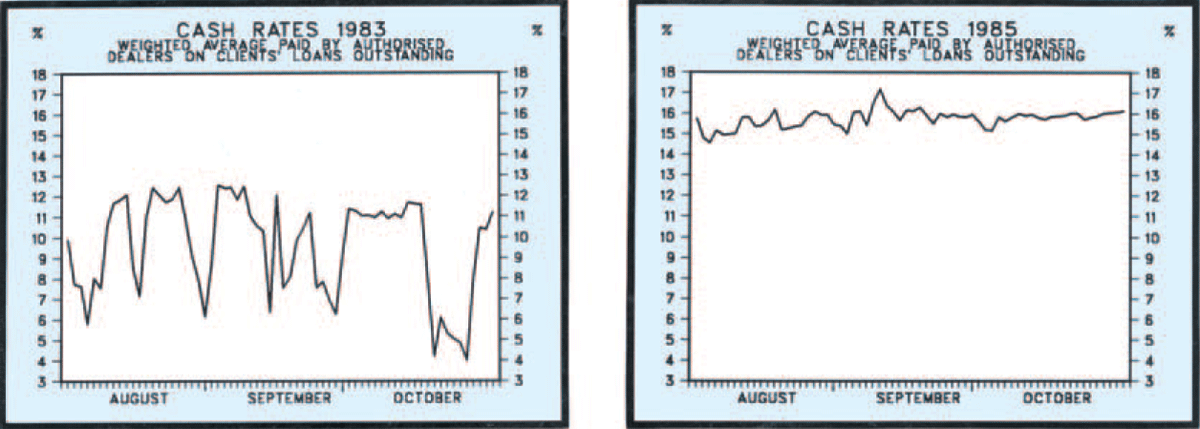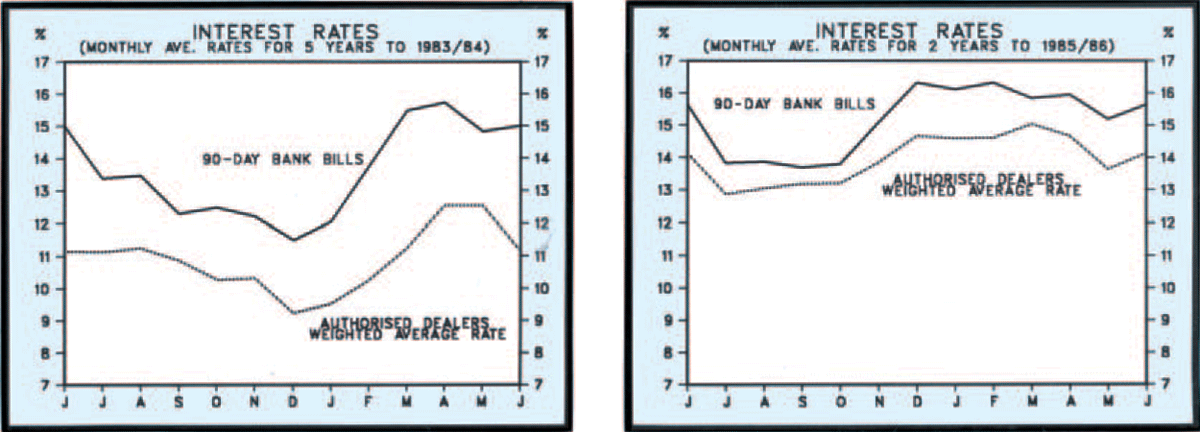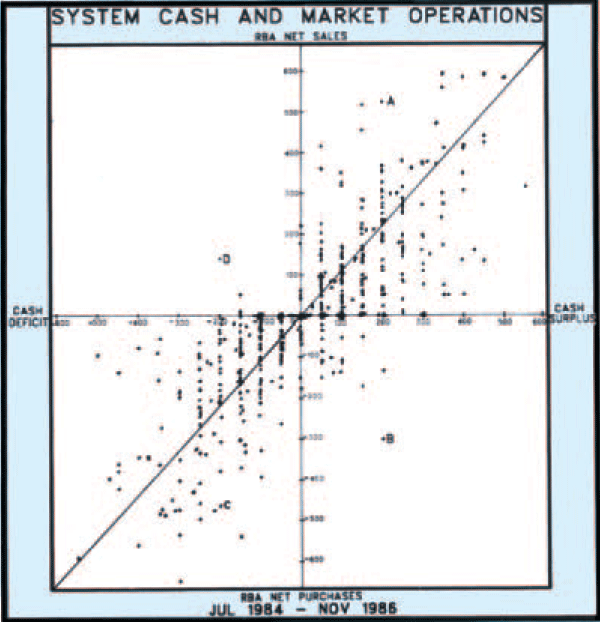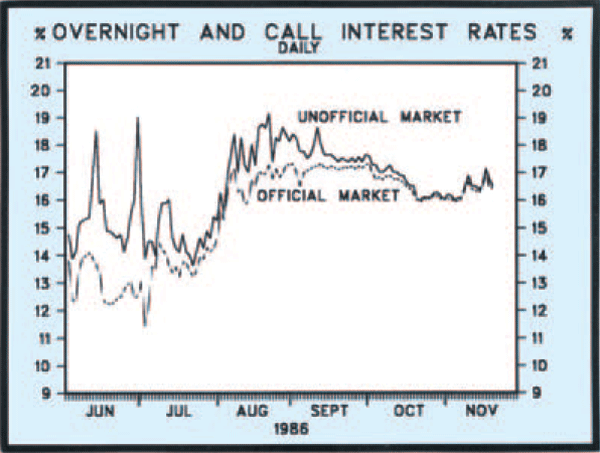Bulletin – December 1986 Open Market Operations Since the Float
- Download 302KB
Paper presented by Mr. I.J. MacJarlane, Chief Manager, Financial Markets Group, Reserve Bank of Australia, to the Victorian Branch of the Economic Society in Melbourne on Wednesday, 26 November 1986.
I have been asked to talk about ‘Operational and technical aspects of liquidity management in the post-float era’. That sounds a rather daunting task so I will try to simplify it as much as I can. Even so, I fear some of it may be a little technical to those among us who do not earn their living in the short-term money market.
In the interests of brevity, this account assumes some familiarity with the current means of implementing monetary policy in Australia. (For those who do not have it, I have referred to articles dealing with this subject.) For example:
- the distinction between debt management and monetary management (as explained in Phillips(2));
- the process whereby government net spending and private sector transactions with the Reserve Bank give rise to a stream of daily injections and withdrawals of cash from the banking system (as explained in RBA(3));
- the means by which the Reserve Bank can buy and sell securities outright and under repurchase agreements in order to influence the availability and cost of cash in the short-term money market (see Forster(l), RBA(4));
- the relationship between the unofficial and official cash markets and the means by which a change in the latter is transmitted to the wider financial market and to the growth of money and credit (see Phillips(2)).
The Significance of the Floating Exchange Rate
Before the float, the Reserve Bank used to clear the foreign exchange market daily at a pre-announced exchange rate. Its action in the foreign exchange market would, therefore, either add to or subtract from cash entering the banking system two days further on.
For example, at times the exchange rate was such that capital was entering Australia in greater quantities than was necessary to cover our current account deficit (i.e. foreign reserves were increasing). The Reserve Bank would buy foreign currency and credit the banks with Australian dollars, thus adding to the daily availability of cash. In turn, it would sell paper to mop up the increase in cash. To the extent that it was successful, it would prop up interest rates and thus prolong the exchange rate/interest rate combination that gave rise to the inflow in the first place (if an attempt was made to tighten domestic conditions, it would increase inflow).
Without exchange rate variability, the system could quickly degenerate into the proverbial case of a dog chasing its tail. It is not surprising that, in such circumstances, there was not a high priority given to using the Bank's daily domestic market operations as a means of achieving monetary policy ends.
With the float this changed. The only foreign exchange transactions that affected the domestic availability of cash were the ones the Reserve Bank chose to do. If it chose to do none, then the whole of any external effect would be taken on the exchange rate with none on domestic cash availability. More importantly, if it was decided to conduct domestic operations in such a way as to tighten or loosen financial conditions, it would no longer be undone by induced flows across the foreign exchanges. In short, it became possible to use domestic open market operations to affect the cost and availability of cash without setting up destabilising international capital movements.
In these new circumstances, it would be expected that open market operations could become more active and more effective. It is possible to show, with the help of a few tables and graphs, that this has been the case.
Volume of dealing
The Reserve Bank now conducts its daily operations more frequently than before the float. In doing so, it absorbs, injects and re-positions larger volumes of cash than formerly.
For example, in 1985/86 the Bank dealt on 75 per cent of days compared with 55 per cent of days in 1982/83 (the last completed financial year before the float). The volume of dealing has also risen quite markedly. In 1985/86 the Bank bought a total of $29.7 billion in its open market operations (bonds, Treasury notes and repurchase agreements) and sold $28.4 billion. The corresponding figures for 1982/83 were less than a quarter of this amount (see Table 1). Part of the increase in volumes was due to more frequent purchases and sales of Commonwealth government securities, but part of it was also due to the use of repurchase agreements which were not introduced until 1984. These have given the Bank greatly enhanced capacity to re-position funds.
| Purchases | Sales | |
|---|---|---|
| 1985/86 | 29.7 | 28.4 |
| 1982/83 | 6.8 | 5.3 |
Variability of interest rates
By being able to avoid periods where the supply of cash was overly plentiful or very scarce, it has been possible to avoid a lot of the variability in cash rates (the rate on overnight and call funds). Before the float, there was a lot of variability that was due to semi-random factors (such as flows across the exchanges). There was also a lot that was due to systematic factors (such as government payments and receipts) which were not offset by the Bank's market operations. There was a common saying in the money market at the time that ‘every day was either a 3 per cent day or a 13 per cent day.’
Panel 1 of Diagram 1 shows the daily observations for official cash rates in the last three completed months before the float. Panel 2 shows the same three-monthly period two years later. The reduction in variability or volatility is quite striking. Note that there has not been a total elimination of variability but it now tends to be confined within a narrower range. The standard deviation of the daily movement in the official cash rate was 2.64 percentage points in the two years before the float. In the three years since the float it has averaged 0.86 per cent.

Seasonality
A particular form of variability in interest rates that characterised the Australian money market was the pronounced seasonal pattern. This was caused by the seasonality in cash rates which flowed through to other short-term interest rates, such as those on commercial bills and Treasury notes. The seasonality in cash rates was due to the seasonal pattern in the government's accounts not being fully offset by the primary issue of government securities (Treasury note tenders) and the Bank's domestic market operations.
Once it became possible to pursue more active market operations and to synchronise Treasury note tenders more closely with the availability of cash, the basic reason for this seasonality in cash rates disappeared. Diagram 2 shows the change that has occurred since the float. The first panel shows the seasonal pattern in the five years to 1983/84 and the second panel shows the seasonal pattern in the last two completed financial years.

Prior to the float, the average pattern was for cash rates to decline in every month in the first half of the financial year, reaching a trough in December. They then rose in the second half of the financial year to peak in April and May. The yield on 90-day bank bills followed almost exactly the same pattern.
Since the float, there has been no tendency for cash rates (or bill rates) to fall in the first six months of the financial year. Indeed, the December observation is the highest in the first half year. In the second half of the year, there is also no tendency for rates to rise and, if anything, they have averaged a bit lower in May than in January. I admit that this is a very small sample for the second period, but if you analyse each year separately and also throw in the experience of this financial year to date, you would have to conclude that the old seasonality in cash rates has largely disappeared.
Some Technical Factors in Reserve Bank Dealing
The logic of Reserve Bank dealing
A simple-minded view of Reserve Bank market operations is that each day it should exactly compensate for the injections or withdrawals of funds as shown in the daily cash position. In other words, if the system was up $200 million, the Bank should sell $200 million of securities and, if it was down $200 million, the Bank should buy $200 million. Some money market participants (and journalists) view this sort of behaviour as being neutral, and are inclined to regard departures from it as indicating a change in policy. I would like to take the opportunity to put this view to rest.
Diagram 3 attempts to put the relationship between the Reserve Bank's dealing and the opening cash position into perspective. On the horizontal axis, it measures the system cash position and, on the vertical axis, it measures Reserve Bank sales and purchases of securities (including under repurchase agreements). The dots on the right-hand side of the diagram show days where the opening cash position is in surplus. Not surprisingly, on most of those days, the Reserve Bank has been a seller. The dots on the left-hand side of the diagram show days when the system cash position has been in deficit and, on most of those occasions, the Reserve Bank was a buyer.

If the Bank had conducted its operations to offset exactly the cash entering or leaving the system, all the observations would have been on a 45 degree line running from the bottom left-hand corner to the top right-hand corner of the diagram. Clearly they are not; there is a wide degree of dispersion around this line. In fact, there are some observations that are in a different quadrant than would be indicated by the line, i.e. surplus days in which the Reserve Bank bought and deficit days in which it sold.
If we take all the days where the cash surplus was $200 million, we can see that Reserve Bank dealing operations have varied from sales of over $500 million (A) to purchases of $300 million (B). Similarly, if we take all the days where the system was in deficit by $200 million, we can see that Reserve Bank dealing operations have varied from purchases of nearly $500 million (C) to sales of $150 million (D).
Why would the Reserve Bank sell on a deficit day or buy on a surplus day? One explanation is that it is deliberately trying to tighten or loosen policy, but it is more likely that these actions are necessary in the normal course of smoothing liquidity conditions in the short-term money market. When a decision is taken on what dealing actions the Bank will undertake, it is taken with reference to a number of factors, only one of which is the day's system cash figure. Two other factors that are at least as important are:
- the likely cash injections or withdrawals in the following days; and
- pressures in the short-term money market as indicated by movements in cash rates.
This first point is worth emphasising. Reserve Bank dealings are just as much influenced by what is likely to happen tomorrow as they are by what is happening today. In some cases, it is the prospect over the next three or four days that is important not just for the next day. (In this sense, deciding on dealing operations is a bit like playing chess – you have to be able to see three or four moves ahead). I might add that the people running the Treasury divisions of banks, authorised dealers and merchant banks also have to plan their day's activities on the basis of the prospects for the coming few days rather than just on the day in question.
An example will illustrate this. If we know that there will be two or three days of heavy inflow of cash into the system, we have to ask whether the Bank can afford to wait until the cash has hit the system and then mop it up or whether it is better to act before the cash has arrived. What normally happens is that banks and other participants in the short-term money market will see that their cash position is going to become flush over the coming few days and so they will stop bidding for funds in the unofficial market and become willing to lend. Thus, in the unofficial market, conditions will ease in anticipation of the future inflows.
When the inflow arrives, if the Bank merely sells securities to match it, this will have limited effectiveness. Banks will have received the cash, lent it to authorised dealers and the Reserve Bank's sales of securities will merely ensure that the dealers acquire assets to match the increase in their loans from banks, rather than reduce their borrowing from other lenders in the unofficial market. It will keep authorised dealers bidding for funds, but it will not stop banks from becoming more cashed up, i.e. having more loans to dealers (or exchange settlement funds)[1]. In other words, if the Reserve Bank pursued the policy of simply waiting for the cash to hit the system, then matching it with sales of securities, it would normally fall behind the game.
Instead, it might decide to ‘over-sell’ on the day before the expected big inflow (or ‘under-buy’); it might even have to do this for two or three days in a row. By over-selling it puts pressure on authorised dealers to borrow in the unofficial market and thus maintains desired firmness in financial conditions. It achieves this by encouraging the market (particularly authorised dealers) to make use of the float[2], that is, to square positions on the day by effectively borrowing against the following day. Every dollar that is borrowed against the following day is a dollar reduction in the size of the opening cash position on the following day. In other words, by ‘over-selling’ it is possible to prevent the following inflows from actually occurring or reduce their volume.
The same applies in reverse it there are going to be substantial withdrawals from the system. It can be much better to buy before they occur than to wait until they have occurred and try to match them with purchases. In the parlance of the short-term money market, the Reserve Bank tries to keep the amount of exchange settlement funds in the system within a reasonably narrow band. If it merely offset the system cash figure after it occurred it would lead to very big swings in the amount of exchange settlement funds in the system, i.e. the banks would sometimes be very cashed up and other times they would be very short of cash. This would lead to big swings in cash rates (as was the case before the float).
The evolution of the system
The short-term money market has changed greatly over recent years. Even in the three years since the float, there have been a number of changes to the rules which have influenced its behaviour. The major ones have been:
- the entry of the banks into the market for overnight and short-term funds (less than 14 days to maturity), August 1984;
- the introduction of trading in repurchase agreements between the Reserve Bank and the authorised dealers in the short-term money market, August 1984; and
- the introduction of trading in repurchase agreements between the authorised dealers and the public, August 1986.
The first two of these changes have been fully digested into the market and have already shown up in the diagrams presented earlier. The third has only been operating for about three months but we are beginning to see the results of it now.
There have been occasions in the past when the Bank has needed to buy large quantities of paper from authorised dealers in order to put cash back into the system. Occasionally this was not easy and caused some hiccups in the market. Mostly it reflected a situation where dealers' books were low and where other holders of Treasury notes and short bonds were reluctant to sell because they were expecting interest rates to decline in the medium term. To overcome this, dealers were permitted to buy (and sell) securities from the public under repurchase agreement. In this way, holders who were unwilling to sell outright could sell under an agreement to repurchase and, therefore, maintain their right to future capital gains.
This also meant that if the unofficial cash rate became a lot higher than the official rate, dealers could buy securities under repurchase agreement and, in a sense, lend funds to the holders of those securities at lower rates than were prevailing in the unofficial market. They could arbitrage away differences between the official and unofficial market that were due to factors other than the normal risk differential. Diagram 4 compares the three months before this change was made with the three months since the change was made. It is quite clear that, as a result of the change, the difference between the official market and unofficial market has narrowed noticeably.

Footnotes
It is important to remember that in the Australian system, banks' cash reserves are held as loans to authorised dealers, not at the central bank (as they are in the United States). In Australia, banks' ‘reserves’ at the Reserve Bank are always effectively at their required level. The Reserve Bank, therefore, seeks to affect banks' loans to dealers, not their reserves at the central bank. This accounts for much of the difference in language (and substance) between descriptions of the US and Australian systems. [1]
Use of the ‘float’ is an extremely important smoothing (or re-positioning) device. When an authorised dealer borrows ‘bank cheque’ funds, the dealer can credit its account at the Reserve Bank and so square its position. The lender's bank is not debited until the following day when the cheque has gone through the overnight clearing system. Thus, the dealer gains funds today by subtracting from the following day's cash inflow (or increasing its outflow). [2]
References
- Forster, J.G., ‘Reserve Bank Money Market Operations’, The Australian Banker, August 1986.
- Phillips, M.J., ‘Monetary Policy from the Inside’, Reserve Bank Bulletin, November 1985.
- Reserve Bank of Australia, ‘Provision of Money Market Information’, Reserve Bank Bulletin, July 1983.
- Reserve Bank of Australia, ‘The Reserve Bank's Domestic Market Operations’, Reserve Bank Bulletin, June 1985.